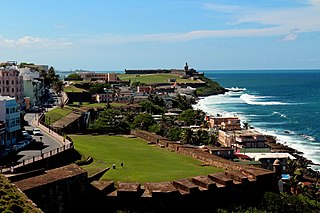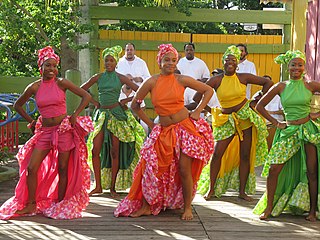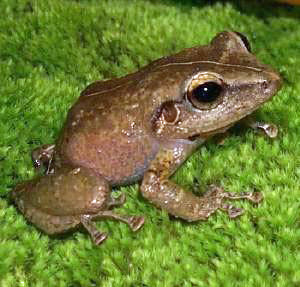
Puerto Rico, officially the Commonwealth of Puerto Rico, is a Caribbean island and unincorporated territory of the United States with official Commonwealth status. It is located in the northeast Caribbean Sea, approximately 1,000 miles (1,600 km) southeast of Miami, Florida, between the Dominican Republic and the U.S. Virgin Islands, and includes the eponymous main island and several smaller islands, such as Mona, Culebra, and Vieques. It has roughly 3.2 million residents, and its capital and most populous city is San Juan. Spanish and English are the official languages of the executive branch of government, though Spanish predominates.

San Juan is the capital city and most populous municipality in the Commonwealth of Puerto Rico, an unincorporated territory of the United States. As of the 2020 census, it is the 57th-largest city under the jurisdiction of the United States, with a population of 342,259. San Juan was founded by Spanish colonists in 1521, who called it Ciudad de Puerto Rico.

A hacienda is an estate, similar to a Roman latifundium, in Spain and the former Spanish Empire. With origins in Andalusia, haciendas were variously plantations, mines or factories, with many haciendas combining these activities. The word is derived from Spanish hacer and haciendo (making), referring to productive business enterprises.

Luis Muñoz Rivera was a Puerto Rican poet, journalist and politician. He was a major figure in the struggle for political autonomy of Puerto Rico in union with Spain.

Juan Cristóbal Gundlach was a German-Cuban naturalist and taxonomist.

Corsican immigration to Puerto Rico resulted in the 19th century from widespread economic and political changes in Europe that made life difficult for the peasant and agricultural classes in Corsica and other territories. The Second Industrial Revolution drew more people into urban areas for work, widespread crop failure resulted from long periods of drought, and crop diseases, and political discontent rose. In the early nineteenth century, Spain lost most of its possessions in the so-called "New World" as its colonies won independence. It feared rebellion in its last two Caribbean colonies: Puerto Rico and Cuba. The Spanish Crown had issued the Royal Decree of Graces of 1815 which fostered and encouraged the immigration of European Catholics, even if not of Spanish origin, to its Caribbean colonies.
German immigration to Puerto Rico began in the early part of the 19th century and continued to increase when German businessmen immigrated and established themselves with their families on the island.

French immigration to Puerto Rico came about as a result of the economic and political situations which occurred in various places such as Louisiana, Saint-Domingue (Haiti) and in Europe.

Afro–Puerto Ricans are Puerto Ricans who are of Black African descent. The history of Puerto Ricans of African descent begins with free African men, known as libertos, who accompanied the Spanish Conquistadors in the invasion of the island. The Spaniards enslaved the Taínos, many of whom died as a result of new infectious diseases and the Spaniards' oppressive colonization efforts. Spain's royal government needed laborers and began to rely on African slavery to staff their mining and fort-building operations. The Crown authorized importing enslaved West Africans. As a result, the majority of the African peoples who entered Puerto Rico were the result of the Atlantic slave trade, and came from many different cultures and peoples of the African continent.

The culture of Puerto Rico is the result of a number of international and indigenous influences, both past and present. Modern cultural manifestations showcase the island's rich history and help to create an identity which is uniquely Puerto Rican - Taíno, Spanish, African, and North American.

The fauna of Puerto Rico is similar to other island archipelago faunas, with high endemism, and low, skewed taxonomic diversity. Bats are the only extant native terrestrial mammals in Puerto Rico. All other terrestrial mammals in the area were introduced by humans, and include species such as cats, goats, sheep, the small Indian mongoose, and escaped monkeys. Marine mammals include dolphins, manatees, and whales. Of the 349 bird species, about 120 breed in the archipelago, and 47.5% are accidental or rare.

The Jewish immigration to Puerto Rico began in the 15th century with the arrival of the anusim who accompanied Christopher Columbus on his second voyage. An open Jewish community did not flourish in the colony because Judaism was prohibited by the Spanish Inquisition. However, many migrated to mountainous parts of the island, far from the central power of San Juan, and continued to self-identify as Jews and practice Crypto-Judaism.

Large-scale Chinese immigration to Puerto Rico and the Caribbean began during the 19th century. Chinese immigrants had to face different obstacles that prohibited or restricted their entry in Puerto Rico.
Ethmia abraxasella is a moth in the family Depressariidae. It is found in Jamaica, Haiti, the Dominican Republic, Puerto Rico, Cuba and the Bahamas. It has also been recorded from southern Florida in the United States.

Synchlora herbaria is a moth in the family Geometridae first described by Johan Christian Fabricius in 1794. It is found in Florida, Cuba, Hispaniola, Puerto Rico, the Bahamas, Antigua, Dominica and the Virgin Islands.
Psychonoctua personalis is a moth in the family Cossidae. It was described by Augustus Radcliffe Grote in 1865. It is found on Cuba, Jamaica, Hispaniola and Puerto Rico.
Aethiophysa savoralis is a moth in the family Crambidae. It was described by Schaus in 1920. It is found in Cuba and Puerto Rico.
Sisyracera contortilinealis is a moth in the family Crambidae. It is found on Puerto Rico, Dominica, Grenada, Jamaica, Cuba and in Guyana.
Lygropia imparalis is a moth in the family Crambidae. It is found in the Dominican Republic, Puerto Rico and Cuba.
Samea carettalis is a moth in the family Crambidae. It is found in Jamaica, Puerto Rico and Cuba.










